To target the millennial market effectively through Snapchat advertising, focus on their engagement and impulse buying behavior. Use Snapchat’s dynamic ads, AR lenses, and filters to create interactive experiences. Highlight emotional triggers and peer influence, as friends play a significant role in purchasing decisions. Set flexible budgets and monitor performance to optimize your campaigns. With millennials’ preferences shaping trends, your approach should adapt. Discover more about leveraging Snapchat’s unique features for better results.
Key Takeaways
- Utilize Snapchat’s dynamic ads to personalize content, enhancing relevance for Millennials and driving impulse purchases.
- Leverage engaging ad formats like AR lenses and filters to create interactive experiences that resonate with younger audiences.
- Implement social proof strategies, as 84% of Millennials take action based on personal recommendations from friends.
- Monitor performance metrics such as swipe-ups and shares to adjust budgets and maximize campaign effectiveness in real-time.
- Emphasize authenticity in messaging to build trust and foster community, aligning with Millennial preferences for genuine brand interactions.
Understanding Snapchat’s User Demographics

When you dive into Snapchat’s user demographics, you’ll quickly notice that the platform is dominated by a young audience, primarily aged 13 to 24. Users aged 18 to 24 make up a substantial share, while those aged 13 to 17 also represent a notable segment.
Gender distribution is nearly balanced, with 48.4% female and 50.7% male users, particularly among the 18 to 24 age group.
Geographically, India leads with over 202 million users, followed by the U.S. with 106 million.
Diverse income levels exist, with 27% earning under $30,000 and 25% over $100,000.
Understanding these demographics helps advertisers craft targeted strategies, ensuring they effectively reach and engage this young, dynamic audience.
The Rise of Millennial and Gen Z Users

Millennials and Gen Z are shaping the future of digital engagement, boasting significant online presence and spending power.
With over 2 billion Millennials and a rapidly growing Gen Z workforce, their buying habits reflect a shift towards impulsive and ethical purchases.
Understanding how these demographics interact with platforms like Snapchat can unlock new marketing opportunities for brands aiming to connect authentically.
User Demographics Overview
As Snapchat continues to evolve, its user base has increasingly shifted toward younger generations, particularly Millennials and Gen Z. You’ll find that 90% of users aged 13-24 engage with the platform, making it a hotspot for youth.
In fact, 58.8% of Snapchat’s users fall between 13 and 24 years old. The largest age group is 18-24, and about 75% of users aged 13-34 are active across over 25 countries.
While users 35 and older make up a smaller portion, the gender distribution remains balanced, with nearly equal numbers of males and females. This demographic landscape highlights Snapchat’s appeal and significance in targeting young audiences effectively. Additionally, the platform’s growing concerns over data privacy have prompted advertisers to be more strategic in their targeting approaches.
Engagement and Spending Power
With a user base predominantly made up of younger generations, Snapchat serves as a dynamic platform for engaging Millennials and Gen Z. These digital natives leverage social media for their purchasing decisions, valuing brands that resonate with them and offer authentic experiences.
You’ll find that Millennials, with an annual spending power of about $69,061, prioritize convenience in their shopping habits. Meanwhile, Gen Z, expected to reach 17% of U.S. spending by 2030, often opts for sustainable choices and digital purchases.
They save a significant portion of their income and enjoy engaging with brands through social media. By understanding these trends, you can tailor your advertising strategies to capture the attention and loyalty of these influential demographics.
Impulse Buying Trends
While many factors influence purchasing decisions, impulse buying among Millennials and Gen Z has surged, driven largely by emotional triggers and social media interactions. A staggering 90.42% of these young shoppers indulge in impulse buying, often spurred by feelings like stress or anger. The power of subconscious influence during moments of emotional decision-making can enhance the likelihood of impulse purchases.
Even though Millennials are slightly less swayed by social media, 16.33% of them still make spontaneous purchases influenced by it, compared to 33.8% of Gen Z. Mobile shopping is nearly as popular as in-store purchases for Millennials, with 48% opting for their phones.
Social platforms like Snapchat significantly impact these trends, as they foster peer pressure and emotional connections, making them ripe for targeted marketing strategies that resonate with younger consumers’ needs and feelings. Additionally, emotional intelligence plays a crucial role in enhancing brand connections and loyalty among these demographics.
Importance of Impulse Purchases in Advertising
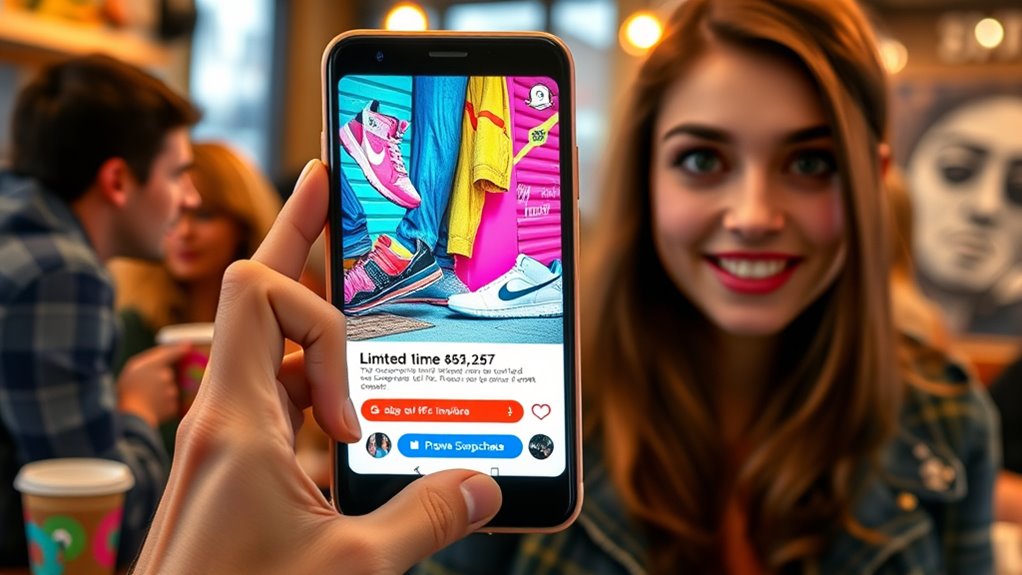
Impulse purchases are a game changer in advertising, especially for platforms like Snapchat.
You can capture attention with engaging ad formats that spark spontaneity and resonate with your targeted audience.
Understanding these trends can help you craft strategies that drive those quick buying decisions.
Impulse Buying Trends
As consumers navigate an increasingly digital marketplace, the significance of impulse purchases in advertising has never been more pronounced. Nearly three out of four Americans make most of their purchases impulsively, with millennials leading the charge.
Even though inflation has made consumers more budget-conscious, this demographic still shows a strong inclination towards spontaneous buying, especially for food, groceries, clothing, and household items. Implementing strategies like automating contributions to savings can help consumers manage these impulse buys without straining their budgets.
Social media platforms like Facebook and TikTok play a crucial role in driving these purchases. Offering incentives like Buy Now, Pay Later options or free shipping can significantly boost impulse buys. Additionally, leveraging Natural Language Processing can enhance customer interactions and further encourage spontaneous purchasing decisions.
Understanding these trends allows you to tailor your advertising strategies, effectively capturing the attention of the millennial market and driving sales.
Engaging Ad Formats
With the rise of impulse buying trends, the way brands engage consumers through advertising is more important than ever.
Snapchat offers several engaging ad formats to capture attention and drive immediate action. Snap Ads provide full-screen video experiences that blend seamlessly with user stories. Collection Ads streamline e-commerce by showcasing multiple products, encouraging quick purchases.
Story Ads enhance brand storytelling in the Discover section, while Lenses and Filter Ads leverage augmented reality for interactive fun. Dynamic Ads adapt to your product catalog, maximizing sales potential.
These formats not only facilitate impulse purchases but also create immersive experiences that resonate with users, making them feel less like ads and more like genuine content. Additionally, harnessing data-driven marketing strategies can further enhance the effectiveness of these ad formats.
Targeted Audience Strategies
While understanding your target audience is crucial for effective advertising, it’s especially important in a platform like Snapchat, where the ephemeral nature of content can lead to quick buying decisions.
Millennials, who make up a significant portion of Snapchat users, are often swayed by peer recommendations and crave seamless mobile experiences. To capitalize on impulse purchases, utilize interest and behavioral targeting to tailor ads that resonate with their values, including sustainability. Staying focused on the specific interests of this demographic can enhance engagement and drive conversions.
Incorporate direct calls to action and limited-time offers that create urgency. The swipe-up feature allows for immediate engagement, enhancing the likelihood of spontaneous purchases. Additionally, consider promoting diverse investment options that align with their interests, as financial literacy is increasingly valued among younger consumers.
Snapchat’s Unique Advertising Features
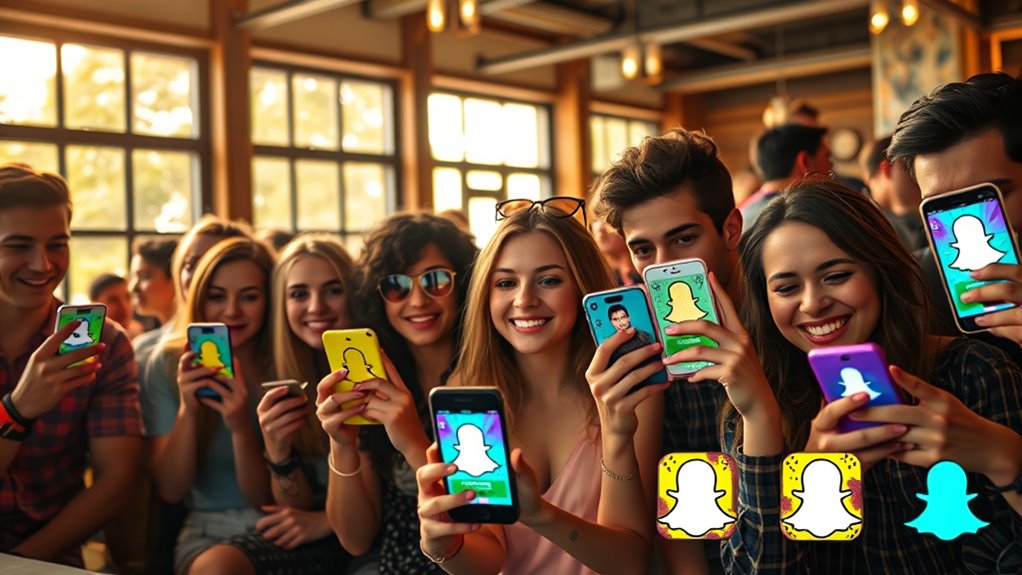
Snapchat offers a range of unique advertising features that can elevate your brand’s visibility and engagement. You can leverage dynamic ads to automate personalized content, ensuring they align with your business goals.
AR lenses and filters create interactive experiences that captivate users and boost brand awareness. Utilize Snapchat’s ephemeral content to deliver timely ads that resonate with your audience.
With location-based targeting, you’ll send relevant messages based on user locations, increasing your ad’s effectiveness. Cross-channel targeting allows you to guide users to their preferred shopping destinations, enhancing their experience.
Effective Strategies for Engaging Millennials
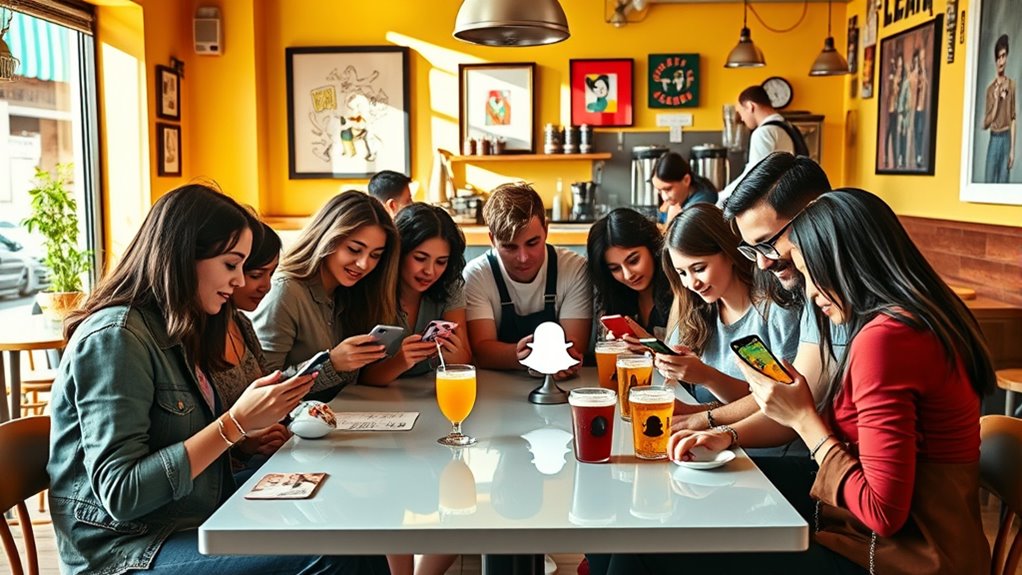
Engaging Millennials requires a thoughtful approach that leverages the unique features of platforms like Snapchat.
Start by creating authentic, shareable content that tells a story rather than just selling a product. Build a sense of community by supporting social or environmental causes, which resonates well with this demographic. Furthermore, brands can enhance their storytelling through AI-driven insights, allowing for more targeted and effective messaging.
Create genuine, story-driven content that fosters community and supports causes important to Millennials.
Personalization is key; use data analytics to tailor experiences that feel unique. Collaborate with influencers who align with your brand’s values to enhance trust and expand your reach.
Encourage user-generated content to foster ownership and belonging, making your audience feel invested.
Lastly, incorporate interactive elements like quizzes or polls to keep Millennials engaged and eager to participate in your brand’s journey. Additionally, employing divergent thinking can help generate innovative campaign ideas that stand out in a crowded market.
The Power of Video Ads on Snapchat

As video content continues to dominate the digital landscape, leveraging video ads on Snapchat can significantly enhance your marketing efforts.
Short-form video ads, especially 6-second ones, prove to be more persuasive than longer formats. With Snapchat’s video ads boasting completion rates five times higher than traditional desktop ads, your message is more likely to resonate.
Users exposed to these ads show a 23% increase in brand recall and a 13% boost in purchase intent. The platform’s full-screen vertical ads double awareness lift, while customizable features let you create engaging content quickly.
Plus, the low cost per action and impressive average return on ad spend of 5.2 make Snapchat a powerful tool for connecting with your audience effectively.
Leveraging Friend Influence in Marketing

Your friends play a huge role in shaping your choices, especially when it comes to brands and products.
Trusting peer recommendations can lead to meaningful engagement within your social circles.
Friends’ Impact on Choices
How do friends shape our purchasing decisions in today’s digital landscape? Friends have a powerful influence on your choices. When you see someone share a positive experience on social media, you’re 58% more likely to act on it.
In fact, 71% of people make purchases based on social media referrals. Word-of-mouth is vital, with 84% of consumers taking action on personal recommendations. Millennials, in particular, rank this influence as their top driver for purchases.
Additionally, 81% of people are swayed by what friends post online. Engaging conversations about brands often lead to valuable insights, making your friends’ opinions crucial in navigating the marketplace.
Trust in Peer Recommendations
Friends’ recommendations play a pivotal role in shaping purchasing decisions, and this influence extends deeply into marketing strategies. When you hear from a friend about a product, you’re more likely to trust that advice.
In fact, 82% of Gen Z rely on family and friends for product suggestions, and 84% of B2B buyers kick off their purchasing journey through referrals. This trust translates into loyalty; customers obtained through referrals have a 37% higher retention rate.
Plus, leads from referrals boast a 30% higher conversion rate than other channels. With 49% of U.S. shoppers discovering brands through their social circles, harnessing peer influence can significantly enhance your marketing efforts on platforms like Snapchat.
Engaging Social Circles Effectively
While tapping into the power of social circles, brands can significantly enhance their marketing strategies on Snapchat.
By collaborating with influencers, you can broaden your brand’s reach among Millennials, leveraging the trust they place in friends. Encouraging user-generated content invites authentic interactions, fostering a community around your brand. This authenticity resonates well with younger audiences, making them more likely to engage with your content.
Additionally, facilitating meaningful conversations through comments and messages strengthens your brand image. As Snapchat users actively share stories, your marketing efforts can go viral, amplifying your message.
Budget Control for Advertisers on Snapchat
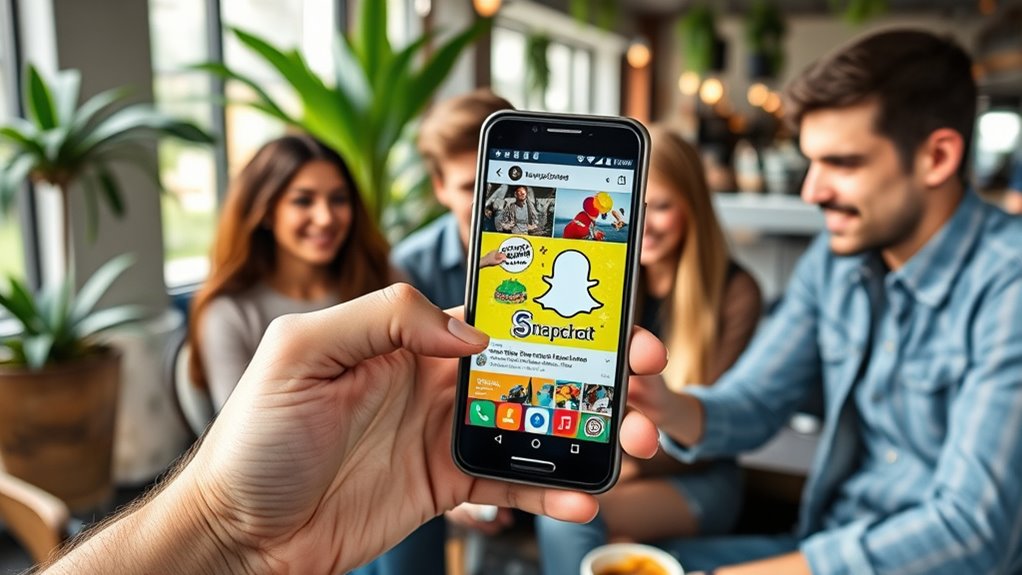
When you advertise on Snapchat, effective budget control is crucial for maximizing your campaign’s success.
Snapchat offers flexible pricing, letting you start and stop ads anytime while setting daily and lifetime spend limits in Ads Manager. You can begin with just $5 daily, but $20-50 is recommended for optimal performance.
Align your budget with specific campaign objectives and adjust in real-time using tools like Triple Whale. Monitor your performance regularly to make informed budget adjustments, and utilize AI-driven recommendations for optimization.
With precise audience targeting and real-time control, you can ensure your budget is used efficiently, delivering high engagement and a strong return on investment.
Measuring Success: Ad Recall and Engagement
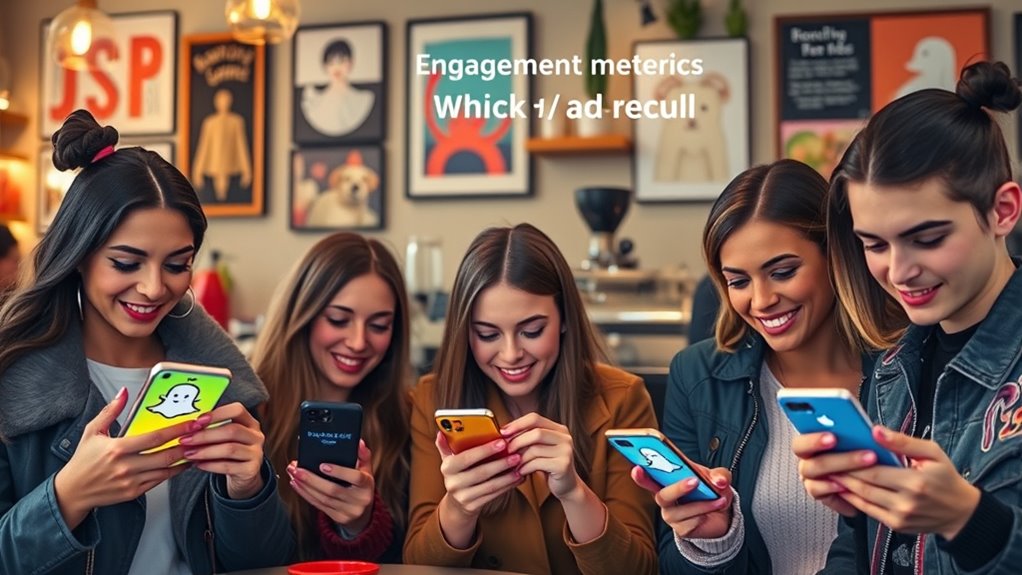
Measuring success in Snapchat advertising hinges on understanding ad recall and engagement.
Success in Snapchat advertising relies on effectively measuring ad recall and user engagement.
You’ll want to track impressions, which show how often your ad’s been viewed, and video views at various lengths to gauge user attention. Engagement metrics like swipe-ups and shares reveal how well users remember and interact with your content.
Keep an eye on audience insights to refine your targeting based on who engages with your ads.
To assess engagement, focus on the swipe-up rate and average screen time; these metrics indicate how captivating your content is.
Future Trends in Snapchat Advertising
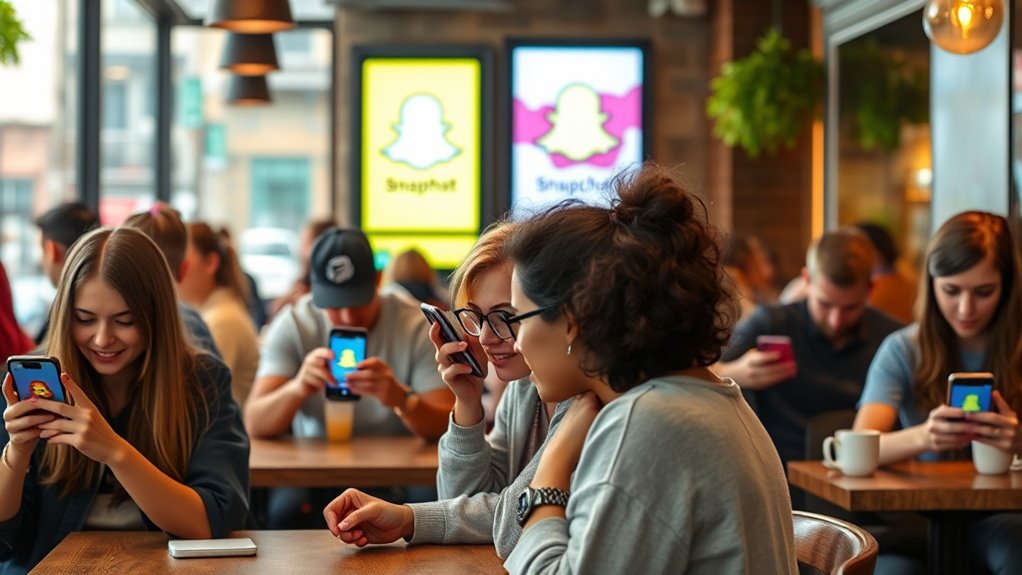
As Snapchat continues to evolve, advertisers must stay ahead of emerging trends to effectively engage their audience.
Augmented Reality (AR) is set to dominate, with 75% of users engaging with AR daily. Expect a 60% rise in virtual try-ons, enhancing product visualization and purchase intent.
Collaborating with niche creators will also gain traction, as authenticity becomes crucial in connecting deeply with communities.
Additionally, Snapchat’s increasing role in PR and brand storytelling means interactive campaigns will thrive, leveraging real-time updates for maximum impact.
With AI-driven personalization enhancing user experiences, voice-controlled AR will offer hands-free interaction, pushing engagement further.
Staying attuned to these trends will be key for brands aiming to capture and retain the millennial market.
Frequently Asked Questions
How Do Snapchat Ads Compare to Other Social Media Platforms?
When you compare Snapchat ads to other social media platforms, you’ll notice distinct advantages.
Snapchat excels in immersive augmented reality experiences and precise targeting, making your ads engaging and relevant.
While TikTok offers dynamic video-first content and a larger user base, Snapchat’s interactive formats can drive high engagement.
Depending on your campaign goals, you might find Snapchat more cost-effective for brand awareness, while TikTok could deliver better ROI for performance marketing.
What Types of Businesses Benefit Most From Snapchat Advertising?
Did you know that 75% of Snapchat users are under 34? This makes it a goldmine for businesses targeting younger audiences.
E-commerce, fashion, beauty, gaming, food, and travel brands thrive on Snapchat due to its visual appeal and engaging formats. You can drive conversions, boost brand awareness, and connect with impulsive buyers.
By leveraging Snapchat’s unique features, you’ll engage effectively and stand out in a crowded marketplace.
Don’t miss out on this opportunity!
Can Snapchat Ads Target Specific Geographical Locations?
Yes, Snapchat ads can definitely target specific geographical locations.
You can use features like radius targeting and geofencing to reach users within a certain distance from your selected point. This means you can deliver relevant ads to potential customers based on their immediate surroundings.
By utilizing Snapchat’s multi-country and metro-level targeting, you can create localized campaigns that enhance user engagement and boost brand awareness effectively.
It’s a powerful tool for any business!
What Is the Average Cost of Advertising on Snapchat?
Wondering how much Snapchat advertising might set you back? The average cost per thousand impressions (CPM) ranges from about $2.95 to $10.01, depending on factors like targeting and ad formats.
You’ll need a minimum spend of $5,000 to $15,000 for your campaigns. Remember, costs can vary based on competition and your chosen bidding strategies, so it’s crucial to plan accordingly for effective budgeting and engagement.
How Often Should Businesses Run Snapchat Ads for Best Results?
To get the best results from your Snapchat ads, aim for a frequency of about two ads per week. This strategy enhances ad recall and drives behavioral change effectively.
If your campaign lasts between 5 to 12 weeks, one ad per week can still yield good results, but shorter campaigns of 1 to 4 weeks need that higher exposure.
Conclusion
In conclusion, Snapchat’s dynamic platform is a goldmine for targeting millennials through engaging, visually appealing ads. By tapping into their impulse buying tendencies and leveraging friend influence, you can create campaigns that resonate. For instance, imagine a fashion brand launching a limited-time clothing line, promoted via Snapchat Stories that feature popular influencers. This approach not only captures attention but drives immediate sales, showcasing the power of Snapchat advertising in reaching the millennial market effectively.










